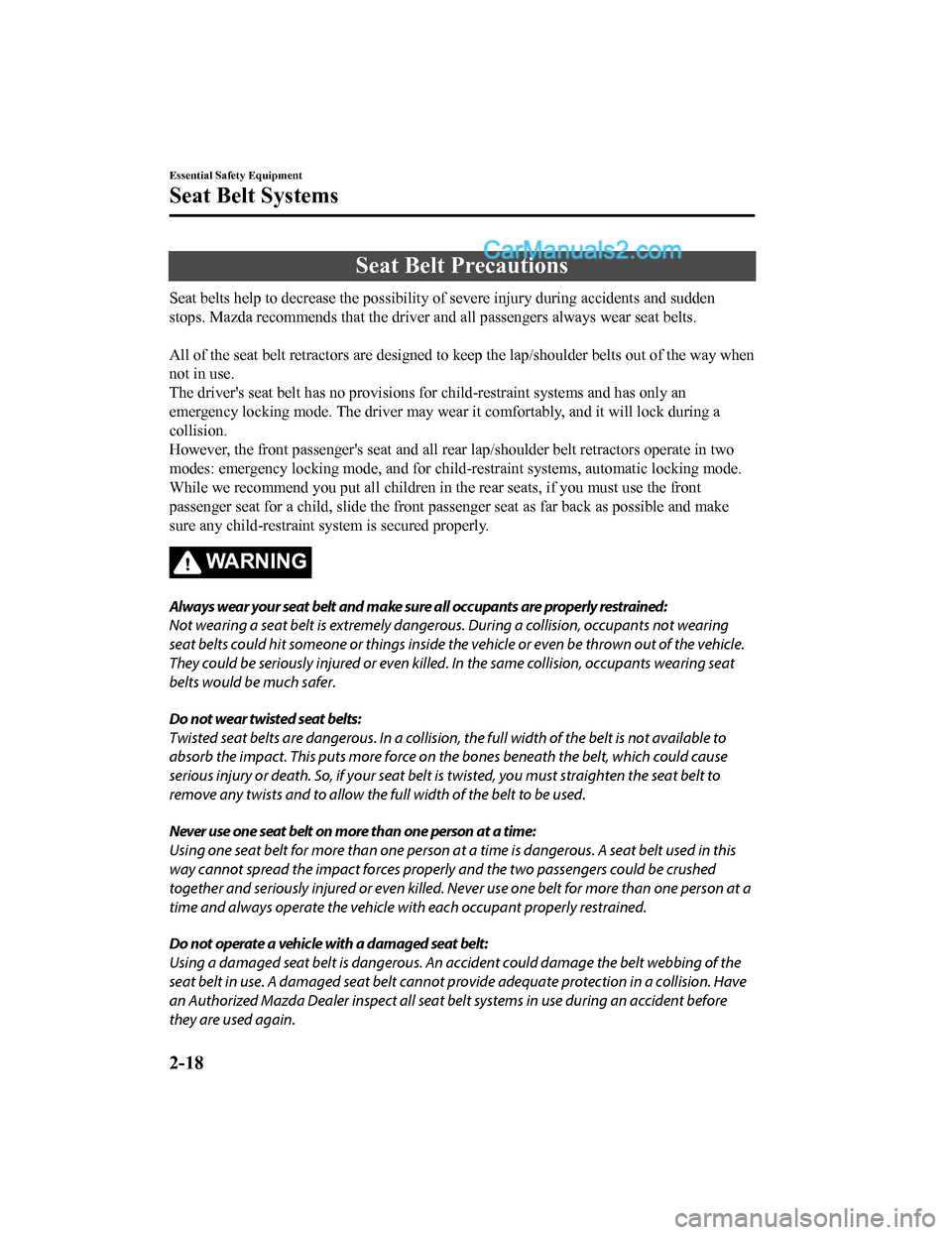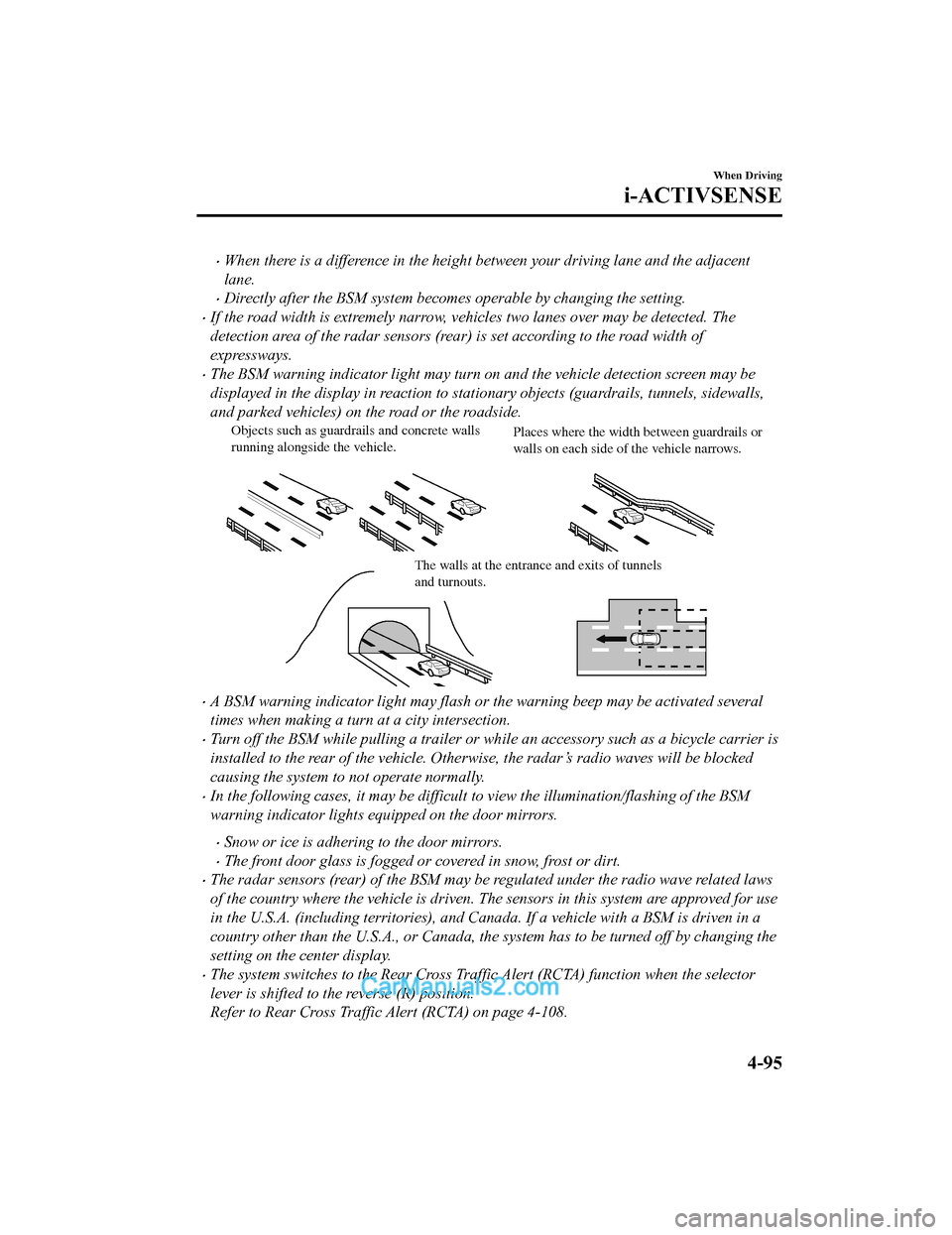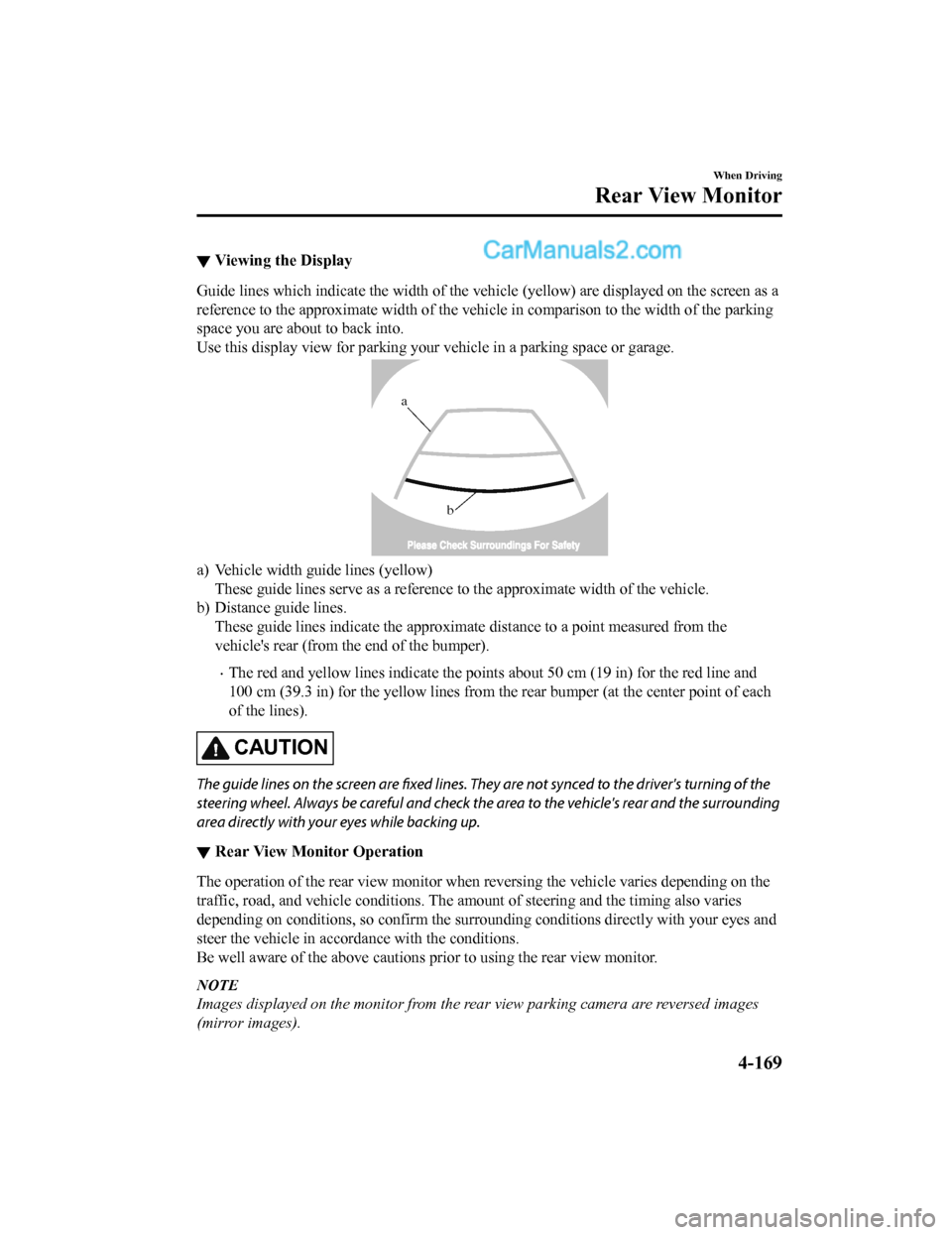width MAZDA MODEL CX-5 2018 Owners Manual (in English)
[x] Cancel search | Manufacturer: MAZDA, Model Year: 2018, Model line: MODEL CX-5, Model: MAZDA MODEL CX-5 2018Pages: 628, PDF Size: 82.38 MB
Page 32 of 628

Seat Belt Precautions
Seat belts help to decrease the possibility of severe injury during accidents and sudden
stops. Mazda recommends that the driver and all passengers always wear seat belts.
All of the seat belt retractors are designed to keep the lap/sh oulder belts out of the way when
not in use.
The driver's seat belt has no provisions for child-restraint sy stems and has only an
emergency locking mode. The driver may wear it comfortably, and it will lock during a
collision.
However, the front passenger's seat and all rear lap/shoulder b elt retractors operate in two
modes: emergency locking mode, and for child-restraint systems, automatic locking mode.
While we recommend you put all chi ldren in the rear seats, if you must use the front
passenger seat for a child, slide the front passenger seat as f ar back as possible and make
sure any child-restraint sy stem is secured properly.
WA R N I N G
Always wear your seat belt and make sure all occupants are properly restrained:
Not wearing a seat belt is extremely dangerous . During a collision, occupants not wearing
seat belts could hit someone or things inside th e vehicle or even be thrown out of the vehicle.
They could be seriously injured or even killed. In the same collision, occupants wearing seat
belts would be much safer.
Do not wear twisted seat belts:
Twisted seat belts are dangerous. In a collision, the full width of the belt is not available to
absorb the impact. This puts more force on the bones beneath the belt, which could cause
serious injury or death. So, if your seat belt is twisted, you must straighten the seat belt to
remove any twists and to allow the full width of the belt to be used.
Never use one seat belt on more than one person at a time:
Using one seat belt for more than one person at a time is dangerous. A seat belt used in this
way cannot spread the impact forces properly and the two passengers could be crushed
together and seriously injured or even killed. Never use one belt for more than one person at a
time and always operate the vehicle with each occupant properly restrained.
Do not operate a vehicle with a damaged seat belt:
Using a damaged seat belt is dangerous. An ac cident could damage the belt webbing of the
seat belt in use. A damaged seat belt cannot pr ovide adequate protection in a collision. Have
an Authorized Mazda Dealer inspect all seat be lt systems in use during an accident before
they are used again.
Essential Safety Equipment
Seat Belt Systems
2-18
CX-5_8GN5-EA-17J_Edition1 2017-8-18 12:58:27
Page 230 of 628

NOTE
•The BSM will operate when all of the following conditions are met:
•The ignition is switched ON.
•The BSM OFF indicator light in the instrument cluster is turned off.
•The vehicle speed is about 10 km/h (6.3 mph) or faster.
•The BSM will not operate under the following circumstances.
•The vehicle speed falls below about 10 km/h (6.3 mph) even though the BSM OFF
indicator light is turned off.
•The selector lever is shifted to r everse (R) and the vehicle is reversing.
•The turning radius is small (making a sharp turn, turning at intersections).
•In the following cases, the BSM OFF indicator light turns on and operation of the system
is stopped. If the BSM OFF indicator light re mains illuminated, have the vehicle inspected
at an Authorized Mazda Dealer as soon as possible.
•Some problem with the system including the BSM warning indicator lights is detected.
•A large deviation in the installation position of a radar sensor (rear) on the vehicle has
occurred.
•There is a large accumulation of snow or ice on the rear bumper near a radar sensor
(rear). Remove any snow, ice or mud on the rear bumper.
•Driving on snow-covered roads for long periods.
•The temperature near the radar sensors (rear) becomes extremely hot due to driving for
long periods on slopes during the summer.
•The battery voltage has decreased.
•Under the following conditions, the radar sensors (rear) cannot detect target objects or it
may be difficult to detect them.
•A vehicle is in the detection area at the rear in an adjacent driving lane but it does not
approach. The BSM determines the condition based on radar detection data.
•A vehicle is traveling alongside your vehicle at nearly the same speed for an extended
period of time.
•Vehicles approaching in the opposite direction.
•A vehicle in an adjacent driving lane is attempting to pass your vehicle.
•A vehicle is in an adjacent lane on a road with extremely wide driving lanes. The
detection area of the radar sensors (rear) is set at the road width of expressways.
•In the following case, the flashing of the BS M warning indicator light, and the activation
of the warning sound and the warning screen indicator display may not occur or they may
be delayed.
•A vehicle makes a lane change from a driving lane two lanes over to an adjacent lane.
•Driving on steep slopes.
•Crossing the summit of a hill or mountain pass.
When Driving
i-ACTIVSENSE
4-94
CX-5_8GN5-EA-17J_Edition1 2017-8-18 12:58:27
Page 231 of 628

•When there is a difference in the height between your driving lane and the adjacent
lane.
•Directly after the BSM system becomes operable by changing the setting.
•If the road width is extremely narrow, vehicles two lanes over may be detected. The
detection area of the radar sensors (rear) is set according to the road width of
expressways.
•The BSM warning indicator light may turn on and the vehicle detection screen may be
displayed in the display in reaction to stationary objects (guardrails, tunnels, sidewalls,
and parked vehicles) on the road or the roadside.
Objects such as guardrails and concrete walls
running alongside the vehicle. Places where the width between guardrails or
walls on each side of the vehicle narrows.
The walls at the entrance and exits of tunnels
and turnouts.
•A BSM warning indicator light may flash or the warning beep may be activated several
times when making a turn at a city intersection.
•Turn off the BSM while pulling a trailer or wh
ile an accessory such as a bicycle carrier is
installed to the rear of the vehicle. Otherwise, the radar’s radio waves will be blocked
causing the system to not operate normally.
•In the following cases, it may be difficult to view the illumination/flashing of the BSM
warning indicator lights equipped on the door mirrors.
•Snow or ice is adhering to the door mirrors.
•The front door glass is fogged or covered in snow, frost or dirt.
•The radar sensors (rear) of the BSM may be regulated under the radio wave related laws
of the country where the vehicle is driven. The sensors in this system are approved for use
in the U.S.A. (including territories), and Canada. If a vehicle with a BSM is driven in a
country other than the U.S.A., or Canada, the system has to be turned off by changing the
setting on the center display.
•The system switches to the Rear Cross Traffic Alert (RCTA) function when the selector
lever is shifted to the reverse (R) position.
Refer to Rear Cross Traffic Alert (RCTA) on page 4-108.
When Driving
i-ACTIVSENSE
4-95
CX-5_8GN5-EA-17J_Edition1 2017-8-18 12:58:27
Page 263 of 628

•Tires other than conventional tires are equipped.
•Vehicle is driven on an intersection or junction, or on a forked road.
•The white (yellow) lane lines are less visible because of dirt or fading/patchiness.
•A vehicle in front of your vehicle is running near a white (yellow) lane line making it
less visible.
•A white (yellow) lane line is less visible because of bad weather (rain, fog, or snow).
•The vehicle is driven on a temporary lane or section with a closed lane resulting from
construction where there may be multiple wh ite (yellow) lane lines or they are
interrupted.
•A misleading line is picked up on the road su ch as a temporary line for construction, or
because of shade, lingering snow, or grooves filled with water.
•The surrounding brightness suddenly changes such as when entering or exiting a
tunnel.
•The illumination of the headlights is weakened because of dirt or the optical axis is
deviated.
•The windshield is dirty or foggy.
•The windshield, camera is fogged (water droplets).
•Back-light is reflected off the road surface.
•The road surface is wet and shiny after rain, or there are puddles on the road.
•The shade of a guardrail parallel to a white (yellow) lane line is cast on the road.
•The width of the driving lane is narrow or wide.
•Driving on roads with tight curves.
•The road is excessively uneven.
•The vehicle is shaken after hitting a road bump.
•There are two or more adjacent white (yellow) lane lines.
•There are various road markings or lane markings of various shapes near an
intersection.
When Driving
i-ACTIVSENSE
4-127
CX-5_8GN5-EA-17J_Edition1 2017-8-18 12:58:27
Page 264 of 628

▼System Operation
Make sure that the LAS & LDWS OFF
indicator light in the
instrument cluster is
turned off. When the LAS & LDWS OFF
indicator light is turned on, press the
switch and make sure that the indicator
light turns off.
The LAS & LDWS indication (white) is
displayed in the multi-information display,
and the system goes on stand-by.
(White)
Drive the vehicle in the center of the
vehicle lane while the system is on
standby. When all of the following
conditions are met, the LAS & LDWS
indication (green) is displayed in the
multi-information display, and the system
becomes operational.
(Green)
•The engine is running.
•The vehicle speed is about 60 km/h (37
mph) or faster.
•The system detects w hite (yellow) lane
lines on both the right and left sides.
•The driver is operating the steering
wheel.
•The driving lane is neither narrow nor
wide.
NOTE
The LAS & LDWS indication is white
when the system detects only a white
(yellow) line on either the left or right, and
the indication changes to green when the
system detects white (yellow) lines on both
the left and right sides.
Detection only on either left or right Detects on both
left and right sides
(White) (Green)
The LAS & LDWS goes on stand-by
status in the following cases:
•The system cannot detect white (yellow)
lane lines.
•The vehicle speed is less than about 60
km/h (37 mph).
•The ABS/TCS is operating.
•The TCS is turned off.
(If the TCS is turned off while the
system is operational, a warning beep is
heard and the system goes on standby.)
•The vehicle is making a sharp curve.
•The brake pedal is depressed.
•The steering wheel is operated abruptly.
•The width of a lane is excessively
narrow or wide.
When Driving
i-ACTIVSENSE
4-128
CX-5_8GN5-EA-17J_Edition1 2017-8-18 12:58:27
Page 305 of 628

▼Viewing the Display
Guide lines which indicate the wid
th of the vehicle (yellow) are displayed on the screen as a
reference to the approximate width of the vehicle in comparison to the width of the parking
space you are about to back into.
Use this display view for parking your vehicle in a parking spa ce or garage.
b
a
a) Vehicle width guide lines (yellow)
These guide lines serve as a reference to the approximate width of the vehicle.
b) Distance guide lines. These guide lines indicate the approximate distance to a point measured from the
vehicle's rear (from the end of the bumper).
•The red and yellow lines indicate the points about 50 cm (19 in ) for the red line and
100 cm (39.3 in) for the yellow l ines from the rear bumper (at the center point of each
of the lines).
CAUTION
The guide lines on the screen are fixed lines. They are not synced to the driver's turning of the
steering wheel. Always be careful and check the area to the vehicle's rear and the surrounding
area directly with your eyes while backing up.
▼ Rear View Monitor Operation
The operation of the rear view monitor when reversing the vehic
le varies depending on the
traffic, road, and vehicle conditions. The amount of steering a nd the timing also varies
depending on conditions, so conf irm the surrounding conditions directly with your eyes and
steer the vehicle in accordance with the conditions.
Be well aware of the above cautions prior to using the rear vie w monitor.
NOTE
Images displayed on the monitor from the rear view parking camera are reversed images
(mirror images).
When Driving
Rear View Monitor
4-169
CX-5_8GN5-EA-17J_Edition1 2017-8-18 12:58:27
Page 306 of 628

1. Shift the selector lever to reverse (R) to switch the display to the rear view monitor
display.
2. Confirming the surrounding conditions, reverse the vehicle.
(Display condition) (Vehicle condition)
3. After your vehicle begins entering the parking space, continue backing up slowly so that
the distance between the vehicle w idth lines and the sides of the parking space on the
left and right are roughly equal.
4. Continue to adjust the steering wheel until the vehicle width guide lines are parallel to
the left and right sides of the parking space.
5. Once they are parallel, straighten the wheels and back your v ehicle slowly into the
parking space. Continue checking the vehicle's surroundings and then stop the vehicle in
the best possible position.
(Display condition) (Vehicle condition)
6. When the selector lever is shifted from reverse (R) to anothe r selector lever position, the
screen returns to the previous display.
When Driving
Rear View Monitor
4-170
CX-5_8GN5-EA-17J_Edition1 2017-8-18 12:58:27
Page 307 of 628

NOTE
•If the parking space has division lines, straighten the wheels when the vehicle width
guide lines are parallel to them.
•Because there may be a difference between the displayed image, such as indicated
below, and the actual conditions when parking, always verify the safety at the rear of
the vehicle and the surrounding area directly with your eyes.
•In the image of the parking space (or garage) displayed on the screen, the back end
and distance guide lines may appear aligned in the monitor, but they may not
actually be aligned on the ground.
•When parking in a space with a division li ne on only one side of the parking space,
the division line and the vehicle width guide line appear aligned in the monitor, but
they may not actually be aligned on the ground.
When Driving
Rear View Monitor
4-171
CX-5_8GN5-EA-17J_Edition1 2017-8-18 12:58:27
Page 485 of 628

▼Replacing a Wheel
WA R N I N G
Always use wheels of the correct size on
your vehicle:
Using a wrong-sized wheel is dangerous.
Braking and handling could be affected,
leading to loss of control and an accident.
CAUTION
A wrong-sized wheel may adversely
affect:
Tire fit
Wheel and bearing life
Ground clearance
Snow-chain clearance
Speedometer calibration
Headlight aim
Bumper height
Tire Pressure Monitoring System
NOTE
•When replacing a wheel, make sure the
new one is the same as the original
factory wheel in diameter, rim width,
and offset (inset/outset).
•For details, contact an Authorized
Mazda Dealer.
Proper tire balancing provides the best
riding comfort and helps reduce tread
wear. Out-of-balance tires can cause
vibration and uneven wear, such as
cupping and flat spots.
Maintenance and Care
Owner Maintenance
6-35
CX-5_8GN5-EA-17J_Edition1 2017-8-18 12:58:27
Page 578 of 628

WA R N I N G
Keep your vehicle's tires properly inflated and not overloaded:
Driving with improperly inflated or overl oaded tires is dangerous. Excessive speed,
underinflation, or excessive loading, either separately or in combination, can cause heat
buildup and possible tire failure. The temperatur e grade for this tire is established for a tire
that is properly inflated and not overloaded.
These grades will be added to the sidewalls of passenger vehicl e tires over the next several
years according to a schedule established by the NHTSA and the tire manufacturers.
The grade of tires available as standard or optional equipment on Mazda vehicles may vary
with respect to grade.
ALL PASSENGER VEHICLE TIRES MUST CONFORM TO THESE GRADES AND TO
ALL OTHER FEDERAL TIRE-SAFETY REQUIREMENTS.
▼ UNIFORM TIRE QUALITY GRADING
Quality grades can be found where applicable on the tire sidewa
ll between tread shoulder
and maximum section width.
For example:
TREADWEAR 200 TRACTION AA TEMPERATURE A
UTQGS MARK (example)
Customer Information and Reporting Safety Defects
Uniform Tire Quality G rading System (UTQGS)
8-22
CX-5_8GN5-EA-17J_Edition1 2017-8-18 12:58:27